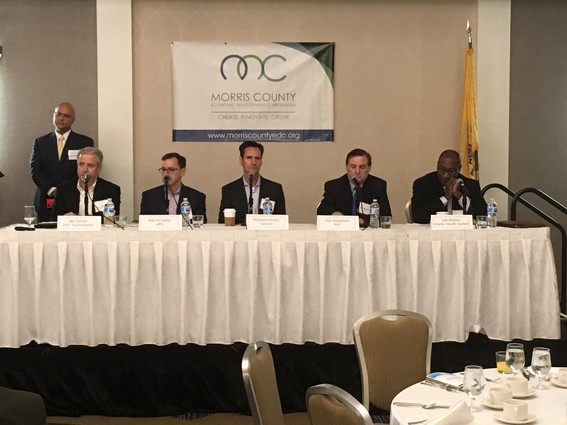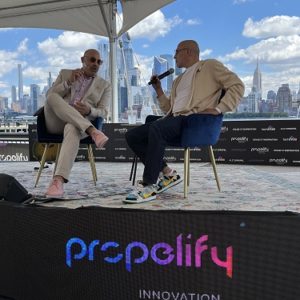Panelists Discuss What Makes a Technology an Innovation at Morris EDC Forum

Experts in the fields of telecommunications, logistics, technology, healthcare, and manufacturing shared insights on how innovation should be defined and its impact on processes, products, and people.
They shared those insights during a panel at the first Morris Country Economic Development Corporation’s Business Growth and Innovation Forum on Nov. 3 at the Sheraton Parsippany hotel.
The panel included speakers Bill Curran, director of information technology at PNY Technologies, a Parsippany-based maker of consumer and business-grade electronics; Ken Finnerty, vice president of customer engagement technology and information at global logistics company UPS (Sandy Springs, Ga); Rick Hornby, executive director of core network technology and planning at Basking Ridge-based Verizon; Don Sebastion, CEO of Newark-based New Jersey Innovation Institute; Joe Wilkens, chief transformation officer at Morristown-based Atlantic Health System, a non-profit healthcare provider. It was moderated by Khizar Sheikh, who chairs the cyber security and privacy law group at Roseland-based law firm Mandelbaum Salsburg.
Sheikh kicked off the discussion with the comment: “Every leader agrees to that it [innovation] is important, but no one can agree to what it means.”
Whatever the definition, innovation requires that a new or improved idea must be perceived as creating value in the marketplace that will be widely used. “Innovation needs to be commercialized. It needs to be adopted and shared in the community,” noted Wilkins.
Hornby added that innovation simply means ”taking a unique idea that adds value from a customer perspective that they would be willing to pay for.”
At PNY Technologies, Curran said the company quickly recognized that emerging technologies, such as artificial intelligence and virtual reality, would play a critical role in finding new ways to drive growth. “We saw the trends coming.”
But who or what decides when an idea, a product or service can earn the distinction of being innovative?
Sebastion said that for something to be truly innovative it must improve or renew an old idea that will be widely accepted in the marketplace. Examples of innovative products and services would include Apple’s iPhone or Uber’s ride-haling program, both which have had a major impact in today’s digital-driven society.
On the other hand, there are ideas that have been touted as innovative but failed to generate any significant or lasting consumer interest.
Sebastion cited the dot-com era dud Pets.com, an online retailer of pet supplies which used the iconic sock puppet as a marketing tool, as a classic example of how some flawed ideas get mistakenly tagged with the word “innovative”. Sebastion summed it up this way: “If it doesn’t provide value, it’s not innovative.”
In the case of Pets.com, the company may have had a good idea but there weren’t enough people using the Internet to buy things back then to support its business model.
Sometimes, external forces will spur innovation within an organization that has been doing essentially the same thing for years.
For an example, Finnerty pointed to how the digital revolution transformed UPS from a company primarily serving the business market to one that has been increasingly focusing its operations on shipping packages to homes as a result of the meteoric growth of online purchases.
With “disruption all over the place,” Finnerty said the digital economy led UPS to think more creatively in expanding its business model to serve this trend. He noted that there has been “significant expectations” to deliver more packages to homes than businesses during the holiday season over the past several years.
Sebastion agreed that companies must greatly emphasize innovation in bringing new products or services to market, in order to thrive in a rapidly changing business environment. He noted that if IBM “stayed as a typewriter company, there would not be an IBM today.”
While technological innovation has dramatically changed the way people work, spend and invest money, stay healthy, and communicate with each other, it can also produce unforeseen consequences, such as the increasing frequency of cyber attacks on business and government IT systems.
“We can find ourselves in trouble if we’re not thoughtful of the implications of innovation,” Wilkens said.

